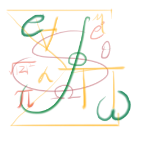On physical grounds, it is desirable to account for collisions amongst particles to understand rare gases.
The Boltzmann equation is widely used to describe rare gases with binary collisions. It models the evolution of
particle probability density function as a function of time which solves a transport equation with a nonlinear term that
accounts for the binary collisions.
Both long and short range interactions can be accomodated in the equation.
Short range interaction are modelled using transport equation with a collisional term that is zero order.
Whereas long range interaction are described using a nonlocal operator
which involves derivatives of the probability density function.
In the near vacuum regime, one expects that the collisions are very rare and hence the nonlinear term can be treated
perturbatively. In fact, Illner--Shinbrot
proved that for short range interactions, this is in fact true and the dynamics is
governed by dispersion coming from the linear transport operator.
Establishing the same for long range interaction proved to be much harder. Recently Luk
proved stability of vacuum using dispersion from linear transport for Landau equation (an approximation for Boltzmann) with moderately soft-potentials.
I proved a similar theorem for Landau equation with hard potential and then for
Boltzmann with moderately soft potentials.
Landau first observed a decay mechanism for linearized Vlasov--Poisson system (which is used to model plasmas) on bounded domains which is different from
dispersion or dissipation. This decay mechanism can be observed easily in fourier space for the linear transport equation. Basically,
information is transported from lower frequency in velocity to higher frequency. Another way to think is that the transport operator homogenizes
initial data and velocity averaged probability density function (also called the density) converges to a constant.
The decay for density in the nonlinear case was only recently understood by Mouhot--Villani.
In a physical plasmas, typically one also has weak collisions which is modelled using the Landau collisional kernel. The action of transport in conjunction with the
collisions gives enhanced dissipation in addition Landau damping. This was done by Bedrossian for a nonlinear
model related to Fokker--Plank using Fourier analytic techniques. But it is not clear how to generalize this technique to the Landau kernel since
it seems very difficult to take Fourier transform in v due to the complicated form of Landau. To bypass this in conjuction with Jonathan Luk and Toan Ngyuen, I used vector field method and energy methods
to prove the analogue of theorem of Bedrossian in https://arxiv.org/abs/2104.05692.
Finally in joint work with Jonathan Luk, I am trying to understand phase mixing in context of gravitational Vlasov--Poisson and Einstein--Vlasov
in presence of an external potential (for example think of a planet or Schwarzschild black hole). See https://arxiv.org/abs/2109.12402 for a linear preliminary result
in 1D.
It is well known that inviscid Burgers equation forms shocks (gradient blow up) starting from smooth initial data.
In fact, this is also quite classical now for 1D system of conservation laws including compressible Euler. The case of higher dimensions
is much less understood. But thanks to combined efforts of Alinhac, Christodoulou, Luk--Speck, Buckmaster--Skholler--Vicol
shock formation has been established in higher dimensions for an open set of smooth data.
Physically, fluids tend to have small but non-zero viscosity. In presence of viscosity, we expect solutions to remain smooth but as noted for zero
viscosity we have singularities. Thus there is something happening in this zero viscosity limit. It would be very interesting to understand how viscosity affects shock formation, i.e.
what does a viscous solution look like near the shock formation point. In an upcoming work with Graham we develop an
asymptotic expansion (in viscosity) for the solution to viscous Burgers equation. In particular, this gives us an understanding of the zero
viscosity limit. We hope to extend this work to 1D systems and then to compressible Euler in higher dimensions.


(Click on title below to show/hide)